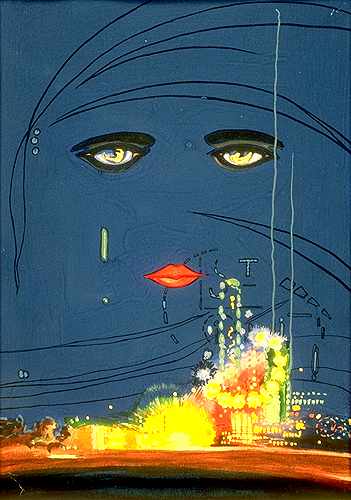So we beat on…
 The last line of The Great Gatsby is one of the most famous lines in American Literature:
The last line of The Great Gatsby is one of the most famous lines in American Literature:
So we beat on, boats against the current, borne ceaselessly into the past.
Who is Trimalchio?
 We know from F. Scott Fitzgerald’s letters to his publishers that he considered calling his novel, Trimalchio in West Egg instead of The Great Gatsby.
We know from F. Scott Fitzgerald’s letters to his publishers that he considered calling his novel, Trimalchio in West Egg instead of The Great Gatsby.
Even though the publishers didn’t share Fitzgerald’s enthusiasm for the title, Trimalchio still makes an appearance in the novel at the beginning of Chapter 7:
“It was when curiosity about Gatsby was at its highest that the lights in his house failed to go on one Saturday night-and, as obscurely as it had begun, his career as Trimalchio was over.”
So who is Trimalchio? And what does he have to do with Gatsby?
Trimalchio, or Gaius Pompeius Trimalchio Maecenatianus, is a character in the roman novel Satyricon written by Petronius over 1,900 years ago.
In the story, Trimalchio, which means “thrice blessed”, was well-known for throwing extravagant dinner parties. During the dinner party related in the Satyricon, Trimalchio engages in grotesque displays of wealth by serving exotic dishes, such as live birds sewn inside a pig and dishes to represent every sign in the zodiac. His guest eat course after course, and talk of everyday life in the Roman Empire, while Trimalchio’s vulgar displays of wealth continue. The night ends with the drunken guests acting out Trimalchio’s funeral for the sake of his amusement.
Gatsby, like Trimalchio, was also know for throwing lavish parties in order to display his wealth and attract the attention of the elusive Daisy Buchanan. There are other subtle similarities between the two…. do you see one?
For more information on Petronius’ Satyricon, roman life, F. Scott Fitzgerald, and the Great Gatsby- visit your local library!
Mint Julep
Despite Prohibition– the period from 1920 to 1933, during which the sale, manufacture, and transportation of alcohol for consumption were banned in the United States- Mint Juleps were the drink of choice for the characters in the Great Gatsby.
To bypass the restrictions on alcohol, Mint Juleps were ordered without alcohol, or ‘virgin’, and then the alcohol, usually Bourbon Whiskey was serupticiously added later.
To Make a Mint Julep
You will need:
To Make:
- Put mint, sugar, and a small amount of crushed or shaved ice into the bottom of a julep cup or tall glass. (Optional: Muddle the mint and sugar, then let stand for a bit to allow the broken leaves to release their flavor.)
- Add bourbon whiskey, top off with crushed or shaved ice, and stir well to mix and chill the libation.
What’s your favourite way to make a Mint Julep?
For more information on Bartending, Cocktails, and Prohibition- visit your local library!
So you want to read The Great Gatsby?
-Free copies (to keep!) are available at Patrick Henry Villiage Library, the European Regional Library, or the Deutsch Amerikanisches Institute. Visit any one of these libraries and ask at the desk.
-Check out The Great Gatsby at Patrick Henry Villiage Library, the European Regional Library, or the Deutsch Amerikanisches Institute.
– For ID card holders we have The Great Gatsby as a downloadable audiobook. Ask a librarian for help.
-For immediate gratification, the full e-text is available free and online here: The Great Gatsby
The Art of The Great Gatsby
Not only is The Great Gatsby known as the Great American Novel- but it’s mysterious cover art is also regarded as a one of the most famous in American literature.
While Fitzgerald was still working on the novel, little-known artist Francis Cugat was commissioned to create the cover art. Not much is known about Cugat, and in fact, the cover art for The Great Gatsby is thought to be the only cover art he ever produced.
Cugat’s painting is was created in the popular Art Deco style, which itself was a decorative style that became synonymous with the roaring 20’s . A pair of eyes and lips float over the lights of a amusement park on a striking blue background. A single green tear falls from the right eye. The irises of the eyes are reclining nudes painted in the ethereal gouache method.
When Fitzgerald saw the finished product, he so admired it that he told his publishers that he had written it “into” the book.
This remark by Fitzgerald have led many to believe that the eyes are similar to the yellow spectacles of Dr. T. J. Eckleburg found in the faded billboard near George Wilson’s auto-repair shop.
From The Great Gatsby: “…Blue and gigantic — their retinas are one yard high. They look out of no face, but, instead, from a pair of enormous yellow spectacles which pass over a non-existent nose.”
Another interpretation is that the floating face is that of Jay Gatsby’s love interest, Daisy Buchanan. In the novel, Daisy is described as the “girl whose disembodied face floated along the dark cornices and blinding signs.”
Visit Heidelberg’s Patrick Henry Villiage Library, the European Regional Library, or the Deutsch Amerikanisches Institutefor more information on F. Scott Fitzgerald, The Great Gatsby, Francis Cugat, Art Deco, and the Roaring 20’s



